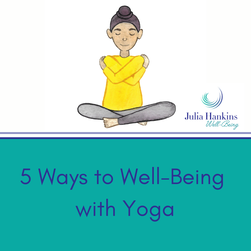|
With children’s mental health week approaching, educators may be thinking of strategies that can work in their setting. Yoga and mindfulness may prove a simple way of enhancing well -being.
Most people are aware of the five ways to wellbeing model. This model can also be used to demonstrate some of the ways that yoga and mindfulness are beneficial. Connect with others Connecting with others is a key way of improving mental health. Children’s yoga classes have a big focus on community and working together. Yoga and mindfulness classes have been found to improve relationships (Finnan, 2015 a) and ‘improve the classroom climate’ (Bazzano, Anderson, Hylton, & Gustat, 2018). Be Active It is widely known that moving the body has mental health benefits. Due to the nature of yoga, it is accessible to all (Chen & Pauwels, 2014), making it a great way of encouraging the least active pupils to participate. The specific type of movements and breathing techniques within yoga, also have the added benefit of engaging the parasympathetic nervous system (Stern, 2019), resulting in calmer children. Take notice A crucial aspect of yoga is connecting with oneself and identifying the sensations of the body. Child psychologist Dr Mona Delahooke (Delahooke, 2022) reports that, having greater awareness of bodily sensations leads to better self- regulation, psychological resilience and mind and body health. Learn Children gain an immense sense of achievement in learning within yoga. Many studies reveal that children experience joy within their yoga sessions, with some teachers believing that children reach a state of ‘flow’ (Rashedi, 2021). Give Helping others and kindness are key themes within yoga. Research suggests that children who learn yoga and mindfulness techniques go on to share these with others (Wang & Hagins, 2016). To children, these activities are fun, novel and don’t feel like learning, yet the adults that use these techniques, know that they are a well-being super power! Why not get some yoga and mindfulness in your setting? Julia Hankins MSc BAQTS EYT Julia Hankins is a member of the Society of Education Consultants and her workshops and trainings are approved by both Yoga Alliance Professionals and The Association for PE. Get in touch to arrange well-being workshops and training for your setting email Julia@juliahankins.co.uk or visit www.juliahankins.co.uk. Works Cited Bazzano, A., Anderson, C., Hylton, C., & Gustat, J. (2018). Effect of Mindfulness and Yoga on Quality of Life for Elementary School Students and Teachers: Results of a randomized controlled school-based study. Psychology Research and Behavior Management, 81 - 89. Chen, D., & Pauwels, L. (2014). Perceived Benefits of Incorporating Yoga into Classroom Teaching: Assessment of the Effects of “Yoga Tools for Teachers”. Advances in Physical Education, 138 - 148. Delahooke, M. (2022). Brain-Body Parenting; How to stop managing behaviour and strat raising joyful resilient kids. Sheldon Press. Finnan, C. (2015 a). Not a Waste of Time: Scheduling Non-academic Learning Activities Into the School Day. Urban Review, 26 - 44. Hughes, J., & Kwol, O. (2007). Influence of Student-Teacher and Parent-Teacher Relationships on Lower Achieving Readers’ Engagement and Achievement in the Primary Grades. Journal of Educational Psychology, 39 - 51. Rashedi, R. (2021). Exploring Teachers’ Perceptions of Implementation Factors in a Yoga Intervention: a qualitative study. Early Years, 365 - 380. Stern, E. (2019). One Simple Thing: A New Look at the Science of Yoga and How it Can Transform Your Life. New York: North Point Press. Wang, D., & Hagins, M. (2016). Perceived Benefits of Yoga among Urban School Students: A Qualitative Analysis. Evidenced Based Complimentary and Alternative Medicine, 1-7.
0 Comments
|
From Julia
Hello! Thanks for being here. If you would like to feel more confident and organised teaching yoga to children, why not sign up to my email list? Archives
March 2024
|


 RSS Feed
RSS Feed